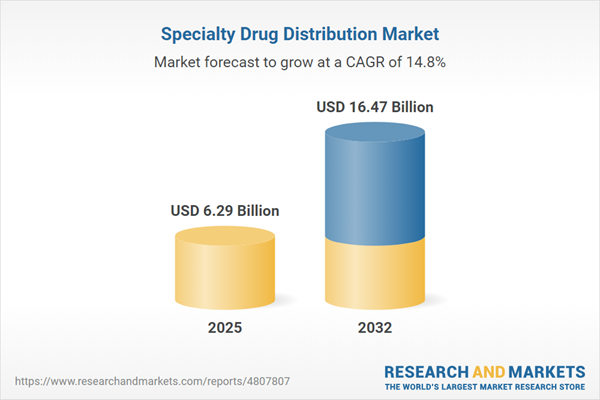Speak directly to the analyst to clarify any post sales queries you may have.
Senior executives in the specialty drug distribution market confront a complex environment marked by evolving regulations, technology integration, and diverse healthcare needs. Effective leadership relies on agility, compliance, and an ability to align operations with shifting market realities.
Market Snapshot: Specialty Drug Distribution Market Overview
The specialty drug distribution market is on an accelerated growth trajectory, with a current valuation of USD 5.47 billion expected to rise to USD 6.29 billion by 2025. Long-term projections estimate the market will reach USD 16.47 billion by 2032, indicating a compound annual growth rate (CAGR) of 14.77%.
Demand is chiefly propelled by increased adoption of advanced specialty therapies, intensifying focus on chronic and rare disease treatment, and the ongoing digital transformation of healthcare supply chains. Market participants are leveraging data-driven logistics and supply chain solutions to enhance transparency, track regulatory changes more efficiently, and adapt to diverse global compliance landscapes. This heightened operational visibility is crucial for adjusting to fast-paced changes in both domestic and international distribution environments.Scope & Segmentation: Specialty Drug Distribution Market
- Therapeutic Areas: The sector services immune disorders, oncology, rare diseases, neurosciences, and infectious diseases. Each therapeutic segment requires distinct operational approaches and regulatory strategies, especially when addressing global distribution and compliance.
- Product Types: Key products include biologics, cell and gene therapies, specialty generics, and small molecules. Ensuring secure transport and handling is vital, given the stringent temperature and safety conditions these products demand to maintain quality and patient safety standards.
- Dosage Forms: Distribution covers pre-filled syringes, injectables, oral solids, vials, and topical formulations. Monitoring storage environments and packaging integrity plays a critical role in safeguarding product efficacy across diverse dosage forms.
- Distribution Channels: Specialty drug distributors reach the market through specialty pharmacies, mail order services, hospital networks, retail locations, direct-to-provider, direct-to-patient offerings, digital distribution, and third-party logistics. This broad channel mix ensures flexibility and broad access in varying care settings.
- Geographies: Operations span the Americas, Europe, the Middle East, Africa, and Asia-Pacific. Each region’s regulatory environment and healthcare infrastructure influence decisions related to entry strategy, compliance, and local partnerships.
- Companies Covered: Leading players such as Cencora, McKesson, Cardinal Health, Walgreens Boots Alliance, CVS Health, Owens & Minor, Morris & Dickson, Anda, FFF Enterprises, and H. D. Smith continuously refine business models to tackle regional logistical and regulatory challenges.
Key Takeaways for Senior Decision-Makers
- Foster stronger partnerships between manufacturers, pharmacy providers, and payers to optimize distribution workflows and harmonize supply chain operations across the healthcare ecosystem.
- Integrate technologies such as IoT, blockchain, and advanced analytics to improve supply chain monitoring and support adherence to distribution standards that continue to evolve.
- Accelerate expansion of direct-to-patient and mail order distribution, reducing geographic bottlenecks and advancing engagement and therapy adherence, particularly for underserved populations.
- Continuously refine compliance frameworks, adapting swiftly to shifting regulatory guidelines to minimize operational interruptions and ensure distribution continuity.
- Strengthen strategic alliances with clinical organizations and healthcare partners to build robust, secure supply networks capable of meeting the needs of specialty drug delivery.
- Align infrastructure investments with region-specific regulatory and logistical demands to promote flexible, scalable market operations and effectively support both established and emerging markets.
Tariff Impact on Specialty Drug Distribution
Forthcoming U.S. tariff adjustments in 2025 will require management teams to reassess sourcing strategies, renegotiate supplier agreements, and evaluate options such as local or near-shoring models. Focused risk assessment and proactive logistics planning are essential to limiting disruptions tied to shifting trade policies and regulatory updates.
Methodology & Data Sources
This report is developed using a combination of peer-reviewed research, regulatory documentation, and direct executive interviews. The synthesis of these sources ensures that the analysis delivers trusted market insights for executive-level strategy development.
Why This Report Matters: B2B Market Research Benefits
- Empowers executive teams to anticipate market and regulatory developments in the specialty drug distribution market with timely, actionable research.
- Strengthens compliance and risk mitigation by consolidating industry-specific analytics and robust research methodologies tailored to B2B decision-making needs.
- Supports the formulation of targeted distribution strategies, helping organizations improve their performance and market reach across both developed and emerging healthcare regions.
Conclusion
Specialty drug distribution leaders benefit from adopting a forward-looking regulatory perspective and prioritizing innovation. This report delivers the strategic context needed to respond effectively to a fast-changing global healthcare market.
Additional Product Information:
- Purchase of this report includes 1 year online access with quarterly updates.
- This report can be updated on request. Please contact our Customer Experience team using the Ask a Question widget on our website.
Table of Contents
3. Executive Summary
4. Market Overview
7. Cumulative Impact of Artificial Intelligence 2025
Companies Mentioned
The companies profiled in this Specialty Drug Distribution market report include:- Cencora, Inc.
- McKesson Corporation
- Cardinal Health, Inc.
- Walgreens Boots Alliance, Inc.
- CVS Health Corporation
- Owens & Minor, Inc.
- Morris & Dickson Co., L.L.C.
- Anda, Inc.
- FFF Enterprises, Inc.
- H. D. Smith, LLC
Table Information
| Report Attribute | Details |
|---|---|
| No. of Pages | 189 |
| Published | November 2025 |
| Forecast Period | 2025 - 2032 |
| Estimated Market Value ( USD | $ 6.29 Billion |
| Forecasted Market Value ( USD | $ 16.47 Billion |
| Compound Annual Growth Rate | 14.7% |
| Regions Covered | Global |
| No. of Companies Mentioned | 11 |









